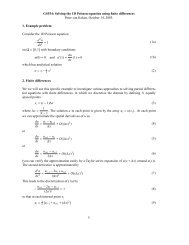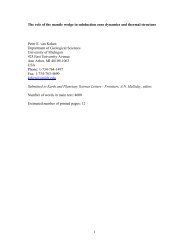Quantitative paleoenvironmental and paleoclimatic reconstruction ...
Quantitative paleoenvironmental and paleoclimatic reconstruction ...
Quantitative paleoenvironmental and paleoclimatic reconstruction ...
Create successful ePaper yourself
Turn your PDF publications into a flip-book with our unique Google optimized e-Paper software.
ARTICLE IN PRESS<br />
26 N.D. Sheldon, N.J. Tabor / Earth-Science Reviews xxx (2009) xxx–xxx<br />
tropospheric CO 2 is isotopically heavier; ~− 6.5 to − 8.0‰ during the<br />
Holocene), but will be isotopically more negative than δ 13 Cvaluesofthe<br />
same mineral that forms in a 2- or 3-CO 2 component soil. Minerals that<br />
may result from one-component soil CO 2 mixing include calcite (Tabor<br />
et al., 2007) <strong>and</strong> siderite (Mozley <strong>and</strong> Carothers, 1992; Mozley <strong>and</strong><br />
Wersin,1992; McMillan <strong>and</strong> Schwertmann,1988; Ludvigson et al.,1998;<br />
White et al., 2005). It is less likely that carbon-bearing minerals that<br />
require oxidizing conditions (e.g., Fe(CO 3 )OH in goethite; Yapp, 2001b)<br />
or free drainage (e.g., occluded CO 2 in gibbsite; Bárdossy <strong>and</strong> White,<br />
1979; Schroeder <strong>and</strong> Melear, 1999) will form in soils characterized by<br />
one component of soil CO 2 .<br />
7.2.2. Two-component soil CO 2<br />
Two-component soil CO 2 mixing assumes that the only two sources<br />
contributing to soil CO 2 are CO 2 from the open atmosphere (tropospheric<br />
CO 2 ) <strong>and</strong> CO 2 from in situ oxidation of biological carbon in the<br />
soil. Steady-state solutions to the one-dimensional Fickian diffusion<br />
equation yield reasonable representations of δ 13 C values of soil CO 2<br />
with depth in modern soils characterized by mixing of two sources of<br />
CO 2 (Cerling, 1984). In these models, the pCO 2 <strong>and</strong> δ 13 C value of Earth's<br />
atmosphere is the upper boundary condition, <strong>and</strong> there is a depthdependent<br />
CO 2 production term that describes the oxidation of organic<br />
carbon in the soil. Above a characteristic CO 2 production depth within<br />
the soil, both the concentration <strong>and</strong> δ 13 C of soil CO 2 will progressively<br />
approach values of the Earth's atmosphere. Thus, CO 2 in soil gas can be<br />
generally regarded as a mixture of two isotopically distinct endmembers<br />
in these soils: atmospheric CO 2 <strong>and</strong> CO 2 derived from in situ<br />
oxidation of soil organic matter (Fig. 16). As mentioned earlier, soil<br />
organic matter δ 13 C values are principally determined by (1) the δ 13 C<br />
of CO 2 in the global troposphere <strong>and</strong> (2) the photosynthetic pathway<br />
employed by primary producers within the soil profile. Therefore, for<br />
times in the geological past when C 3 photosynthesis was the dominant<br />
floral metabolism (pre-Miocene time; see 8.6) <strong>and</strong> soil organic matter<br />
δ 13 C exhibited minimal temporal or spatial variation (e.g., Tabor et al.,<br />
2004a,b; Peters-Kottig et al., 2006; Montañez et al., 2007), stratigraphic<br />
changes in mineral δ 13 C values among paleosol profiles may<br />
indicate either (1) variations in soil productivity (i.e., the concentration<br />
of CO 2 derived from in situ oxidation of organic matter) or (2)<br />
changes in atmospheric pCO 2 . In this regard, δ 13 C values of carbonbearing<br />
pedogenic minerals which formed in the presence of twocomponent<br />
soil CO 2 mixing have the potential to provide information<br />
about (1) paleoecology <strong>and</strong> (2) the concentration of CO 2 in ancient<br />
atmospheres. Pedogenic minerals which provide geochemical records<br />
of two-component soil CO 2 mixing include calcite (Cerling,1991; Mora<br />
et al., 1996; Yapp <strong>and</strong> Poths, 1996; Ekart et al., 1999; Tabor et al., 2004a,<br />
b), goethite (Yapp, 1987a,b; Yapp <strong>and</strong> Poths, 1992, 1993, 1996; Yapp,<br />
2004; Tabor et al., 2004a,b; Tabor <strong>and</strong> Yapp, 2005a), <strong>and</strong> gibbsite<br />
(Schroeder <strong>and</strong> Melear, 1999; Tabor <strong>and</strong> Yapp, 2005a,b; Schroeder<br />
et al., 2006). Of these minerals, only the geochemistry of calcite <strong>and</strong><br />
goethite are sufficiently understood to permit estimates of atmospheric<br />
pCO 2 . Both pedogenic calcite <strong>and</strong> goethite are relatively<br />
abundant in the terrestrial stratigraphic record, <strong>and</strong> thus have the<br />
potential to provide a relatively continuous Phanerozoic record of<br />
paleoatmospheric pCO 2 (see Section 7.4.3.1; Ekart et al., 1999) that<br />
may be cross-checked by independent proxy methods (Yapp <strong>and</strong><br />
Poths, 1996; Tabor et al., 2004a,b).<br />
Fig. 16. Steady-state model plot of soil depth in meters versus (A) soil CO 2 concentration <strong>and</strong> (B) δ 13 C values of soil CO 2 <strong>and</strong> pedogenic calcite. Solution to the soil CO 2 concentrations<br />
assumes Fickian, one-dimensional diffusion, of the form<br />
0 1<br />
ð/ = D s Þ × 1− e − z = Z<br />
pCO 2 = @<br />
410 6 A + 300<br />
22<br />
where ϕ is the production rate of CO 2 in the soil in gC cm − 3 h − 1 ,D s is the diffusion coefficient for gas through the soil, z is depth in meters in the soil, <strong>and</strong> Z is a scaling depth in meters,<br />
also called the characteristic production depth of CO 2 (Cerling, 1991) in the soil. This model soil is calculated with ϕ=0.00002 gC cm − 3 h − 1 , D s =0.0001, <strong>and</strong> Z=0.2, <strong>and</strong> 300 ppmV<br />
as the upper boundary limit of the soil (i.e., a tropospheric pCO 2 of 300 ppmV). Soil CO 2 δ 13 C values were calculated as a mass balance of tropospheric CO 2 (300 ppmV through<br />
profile) with δ 13 C value of − 6.5‰ (a reasonable pre-industrial age value; Schlesinger, 1997) <strong>and</strong> CO 2 from oxidation of organic matter (variable concentrations) with δ 13 C value of −<br />
6.5‰ (i.e., organic matter δ 13 C=− 26.4‰). Soil calcite δ 13 C values were calculated using the CO 2 -calcite carbon isotope fractionation equation of Bottinga (1968) with assumed<br />
calcite crystallization temperatures of 25 °C <strong>and</strong> mildly alkaline soil solution. See Text for discussion.<br />
Please cite this article as: Sheldon, N.D., Tabor, N.J., <strong>Quantitative</strong> <strong>paleoenvironmental</strong> <strong>and</strong> <strong>paleoclimatic</strong> <strong>reconstruction</strong> using paleosols, Earth-<br />
Science Reviews (2009), doi:10.1016/j.earscirev.2009.03.004















